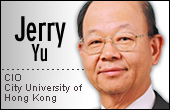Delivering IT as a service

 |
CIO 1-on-1 IT in education took on new meaning when Jerry Yu was appointed chief information officer (CIO) of Hong Kong's City University in December 2000.
With more than 30 years of experience in higher education and IT, Yu was tasked to inject a new lease of life into how IT was run and how student learning was delivered. This meant enabling better management and provision of IT services, as well as finding ways to incorporate the use of IT for student learning in every course.
Yu, well known as the first CIO to be appointed among educational institutes in Hong Kong, says the CIO job is still new in many organizations. "Its role or function is not well defined or clearly understood," he said.
In a recent e-mail interview with ZDNet Asia, Yu outlines the challenges facing CIOs and shares what he thinks are his team's top three achievements since he took on the IT management role six years ago.
He also reveals how he and his team are working to achieve the organization's objectives, which include developing a "well-run IT department...where [each] service is available to the users any time, at a flip of a switch".
Q. In 2000, you became the first CIO the City University of Hong Kong has ever appointed, and it was the first post of its kind among educational institutions in Hong Kong. What did the university expect from you?
Yu: In 2000, I was asked to oversee the work of the university's library and the Computer Services Center. We had a strategic objective to use IT effectively, to support teaching, research and administration. We also wanted to adopt a much more proactive and integrative approach to the provision of IT services. Information and knowledge management have always played an important role in the university environment, as demonstrated by the value placed traditionally on the library.
How has the IT organization evolved over the last six years?
I believe we have evolved successfully from being a provider of information technology services to becoming a provider of information services. The offices I oversee have evolved into three units, each with its own mission: Computer Services Center (institutional IT infrastructure), Enterprise Solutions Center (institutional data management) and Library (institutional knowledge management).
Name |
What are some of the unique characteristics or demands of managing IT for an educational institute, compared to other industries like banking or logistics?
An educational institution, especially one that is publicly funded, has very different cultures and values from that of a commercial or business organization. Commonly adopted measures such as returns on investment and value for money, are often less precisely determined when deciding on IT investments. The applications of IT in an educational institution are also much more diverse...and we have to fulfil the role of teaching students to use IT.
List three major achievements of the past six years.
The first is the installation of a campus network that is robust and reliable. This was not a one-time operation, but a continuous process to monitor, replace or enhance the components of the network to ensure quality service, 24 hours a day. We have had no unscheduled interruption of service for more than a year.
The second is the implementation of an integrated ERP (enterprise resource planning) system that covers the university's major administrative functions. The ERP system is called Banner from SunGard Higher Education. The major components of the system were completed in 2004. The system provides an integrated database on all the constituents of the university: staff, student and alumni. It is used to support both daily administrative functions and long-term planning and development.
The third is unifying the platform for e-learning. Before 2005, the university more or less left individual instructors to decide what, and how, they wanted to use IT to support their teaching. This resulted in the university supporting several software packages, some of which were developed in-house.
In 2005, we decided to support the use of IT for student learning as an institutional initiative. We evaluated the products available at that time and decided to use Blackboard as the common platform. (Blackboard is a provider of enterprise software applications and services related to the education industry.) We have now completed the conversion of all the courses that use other software packages to Blackboard.
We are also moving close to our goal of incorporating the use of IT for student learning in every course.
What is on your IT agenda this year?
The core business of a university is student learning. Our main effort in the coming year will be to continue to develop ways to use IT to help students learn. The use of IT for student learning covers many aspects of the learning activities. Applications that we are exploring include course management, content (authoring, delivery and management), collaboration, outcome assessment, e-portfolio and discipline specific learning activities, such as language studies.
Name three challenges of being a CIO.
The CIO job is new in many organizations and its role or function is not well defined or clearly understood within the organization. This can be partly attributed to the rapid advances in information technology in the past decade, and many organizations are still unsure about what role IT will play in their operation. However, since information/knowledge is so central to the work of any organization, the challenge for the CIO is to ensure that IT is used properly and effectively to further the work or objective of the organization, and to ensure solutions implemented are sustainable.
When it comes to managing IT, what have the years of experience taught you?
It's about the management of change. Things change with time, and it is important to incorporate this factor when considering any IT applications.
To some, quality IT service management is something that just looks and sounds good on paper, but takes a lot of money and effort. What is your view?
There are many examples where quality IT service has a transformational effect on the work of an institution.
What are the hallmarks of a well-run IT department, and to what extent does yours meet all requirements?
A well-run IT department should be like a utility service, similar to electricity or water, where the service is available to the users any time at the flip of a switch. I am hoping that we are getting close to that.